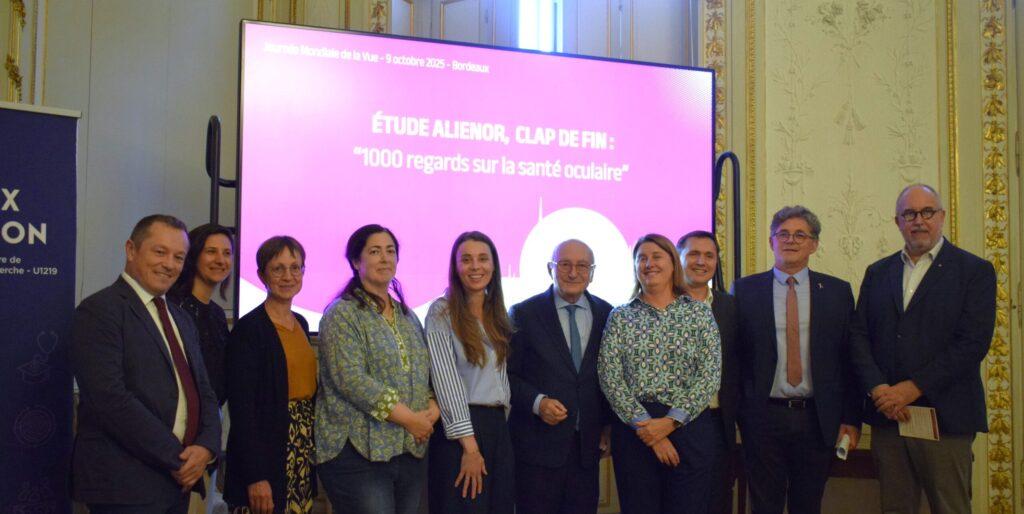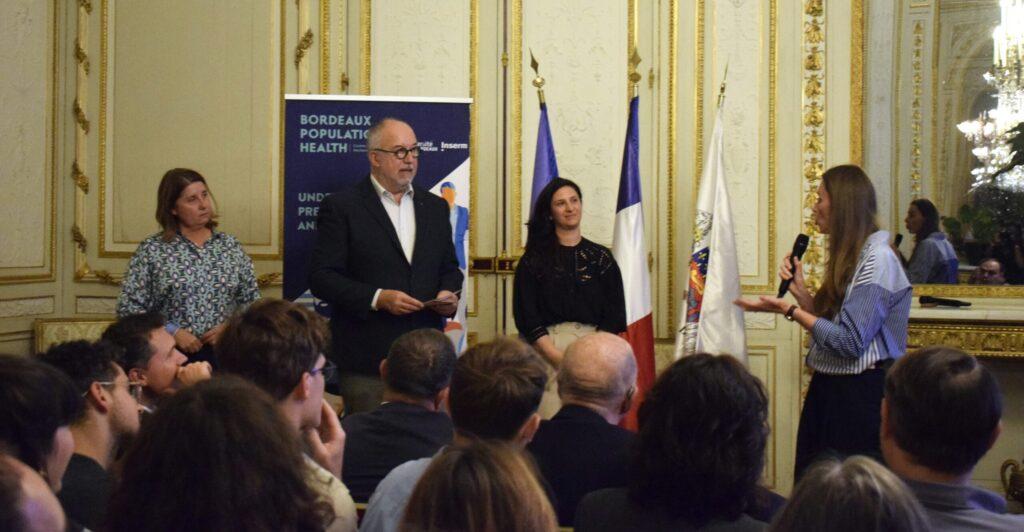ALIENOR study, final event: 1,000 looks at eye health
RetourOn 9 October 2025 for World Eyesight Day, the closing ceremony for ALIENOR, the epidemiological cohort study on ocular ageing, was held.
After 18 years of data collection and analysis, this is an opportunity to look back on the major advances made possible by the study and those yet to come

Photo de Laetitia HOUINOU : Sylvain Bouton , Laure Gayraud, Catherine Helmer, Marie Noelle Delyfer, Bénédicte Merle, Henri Chibret, Cécile Delcourt, Cedric Schweitzer, François SADRAN, Jean François Korobelnik
The ALIENOR study is an epidemiological cohort study conducted on general population aged over 65.
Participants are part of the Trois-Cités (3C) cohort, which includes nearly 10 000 people in three French cities: Bordeaux, Dijon and Montpellier.
In Bordeaux, 1 013 volunteers took part in the ALIENOR study. All of them received eye examinations every 2 to 3 years over a period of 18 years, using innovative techniques that enabled data to be collected for analysis over many years.
Age-related diseases progress over time. In order to study the different stages of development and progression of these diseases, follow-up must also be conducted over a long period of time. This is why epidemiological cohort studies of this type are so valuable to research.

Photo de Laetitia HOUINOU : Cécile Delcourt, Jean François Korobelnik, Laure Gayraud, Bénédicte Merle
The ALIENOR study was created after the POLA study, which was done in Sète, in the Hérault region.
That earlier study showed how important lifestyle is in eye diseases, like smoking, nutrition, or UV exposure.
Upon her arrival in Bordeaux, Cécile Delcourt wanted to take things further, with the main objective of studying the role of nutrition in the onset of eye diseases such as age-related macular degeneration (AMD), cataracts and glaucoma, without forgetting the many other factors such as genetics, lifestyle and environmental exposure.
This objective has been largely achieved, with nearly 66 scientific articles, 100 papers, 8 science theses, 13 medical theses, a start-up founded by a former doctoral student, Soufiane Ajana, and high media visibility, with appearances and reports on France 2, France 3, France Inter, Le Monde, Le Figaro, France Culture and The Washington Post.
But above all, major advances, such as:
- The role of the Mediterranean diet in the progression of AMD, demonstrated by Bénédicte Merle, with a 40% reduction of progression risk in people who follow this type of diet, i.e. rich in fruit and vegetables, cereals, olive oil and fish, with moderate consumption of meat and dairy products. Bénédicte also showed an association between blood concentrations of several nutrients, such as long-chain omega-3 fatty acids, carotenoids and certain vitamins, with AMD but also with ageing of the optic nerve.
- Catherine Helmer and Sara Lima Rebouças investigated the relationship between ocular ageing and cerebral ageing, and highlighted associations between the vascular structures and nerves of the retina and accelerated cerebral ageing.
- The ophthalmology team (Jean-François Korobelnik, Marie-Noëlle Delyfer and Cédric Schweitzer) has identified early biomarkers.
In 2025, Petra Larsen published an article showing a change in the layers of the retina preceding AMD. These measurements, made possible by a routine clinical imaging technique called OCT, could enable early identification of people most at risk of AMD and provide a better understanding of the mechanisms involved in the development of this disease.
- Finally, Laure Gayraud has shown that people who are more exposed to air pollution show an accelerated loss of nerve fibres in the retina. This loss of nerve fibres is a characteristic of glaucoma, suggesting a possible increase in the risk of glaucoma in relation to air pollution.

Photo de Laetitia HOUINOU : Pierre Hurmic, maire de Bordeaux
What now ?
Although the ALIENOR study ended in the field in 2024, research continues. The team now has an exceptionally rich biobank and database, which will continue to contribute to many projects.
Collaborations are already underway within large national cohorts such as Gazel, Constances and E3N-Générations, as well as in the SHIVA and VBHI programmes, to explore the relationship between the retina and the brain in more detail.
Finally, in 2026, a new study will be launched: the Clémence cohort, dedicated to children’s eye health. Faced with an epidemic of myopia, which already affects more than 8 out of 10 young people in major Asian cities and nearly 1 in 2 young Europeans, this cohort will be one of the few in Europe to explore this topic.
Alienor – Étude épidémiologique sur le vieillissement oculaire à Bordeaux


